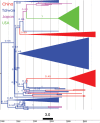Phylodynamics of hepatitis B virus genotype B in East Asia: A population genomics analysis
- PMID: 40200946
- PMCID: PMC11973052
- DOI: 10.14440/jbm.2025.0084
Phylodynamics of hepatitis B virus genotype B in East Asia: A population genomics analysis
Abstract
Background: Hepatitis B virus (HBV) genotype B (HBV/B) is the predominant strain in Taiwan and several East Asian countries.
Objective: The aim of this study is to use comprehensive phylogenetic analysis tools to monitor the long-term molecular evolution dynamic of HBV genotype B population in East Asia.
Methods: In this study, full genome sequences of HBV with temporal information were extracted from GenBank and analyzed using the Bayesian Markov chain Monte Carlo method to identify best-fitting coalescent models.
Results: Bayesian Skygrid analysis revealed a viral effective population (phylodynamic) bottleneck for HBV/B in 2003, a pattern similar to the previously described HBV genotype C (HBV/C). Despite these similarities, the viral dynamics for HBV/B and HBV/C diverged after 2005. HBV/C exhibited a marked decrease in genetic diversity across East Asia, whereas HBV/B maintained stable genetic diversity after 2005. Phylogeographic analysis using Neighbor-Joining and Bayesian maximum clade credibility trees indicated that Taiwan was likely the geographic origin of the most recent common ancestor of HBV/B in East Asia. An early clade spread to Japan and subsequently to the West Coast of the United States of America. Another clade dispersed to China, spread widely across the region, and was reintroduced to Taiwan multiple times. In contrast, HBV/C likely originated in China and spread to Japan, Korea, and Taiwan over several decades.
Conclusion: This study highlights the similarities and differences between the viral dynamics and geographical evolutionary pathways between HBV/B and HBV/C.
Keywords: Bottleneck; East Asia; HBV genotype B; Most recent common ancestor; Phylogeography.
Copyright: © 2025 Author(s).
Conflict of interest statement
The authors declare that they have no competing interests.
Figures





Similar articles
-
Origin and dissemination of hepatitis B virus genotype C in East Asia revealed by phylodynamic analysis and historical correlates.J Viral Hepat. 2019 Jan;26(1):145-154. doi: 10.1111/jvh.13006. Epub 2018 Oct 17. J Viral Hepat. 2019. PMID: 30199591 Free PMC article.
-
Reliable timescale inference of HBV genotype A origin and phylodynamics.Infect Genet Evol. 2015 Jun;32:361-9. doi: 10.1016/j.meegid.2015.03.009. Epub 2015 Mar 14. Infect Genet Evol. 2015. PMID: 25784568
-
Evolutionary history of hepatitis B virus genotype H.J Med Virol. 2021 Jun;93(6):4004-4009. doi: 10.1002/jmv.26463. Epub 2020 Sep 29. J Med Virol. 2021. PMID: 32852054
-
Treatment of chronic hepatitis C in Asia: when East meets West.J Gastroenterol Hepatol. 2009 Mar;24(3):336-45. doi: 10.1111/j.1440-1746.2009.05789.x. J Gastroenterol Hepatol. 2009. PMID: 19335784 Review.
-
Reconstruction of the origin and dispersal of the worldwide dominant Hepatitis B Virus subgenotype D1.Virus Evol. 2022 Apr 8;8(1):veac028. doi: 10.1093/ve/veac028. eCollection 2022. Virus Evol. 2022. PMID: 35712523 Free PMC article. Review.
References
LinkOut - more resources
Full Text Sources
